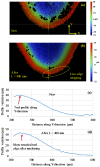Comparative Evaluation of Surface Quality, Tool Wear, and Specific Cutting Energy for Wiper and Conventional Carbide Inserts in Hard Turning of AISI 4340 Alloy Steel
- PMID: 33228121
- PMCID: PMC7699413
- DOI: 10.3390/ma13225233
Comparative Evaluation of Surface Quality, Tool Wear, and Specific Cutting Energy for Wiper and Conventional Carbide Inserts in Hard Turning of AISI 4340 Alloy Steel
Abstract
This paper presents an experimental study into the comparative response of wiper and round-nose conventional carbide inserts coated with TiCN + AL2O3 + TiN when turning an AISI 4340 steel alloy. The optimal process parameters, as identified by pre-experiments, were used for both types of inserts to determine the machined surface quality, tool wear, and specific cutting energy for different cutting lengths. The wiper inserts provided a substantial improvement in the attainable surface quality compared with the results obtained using conventional inserts under optimal cutting conditions for the entire range of the machined lengths. In addition, the conventional inserts showed a dramatic increase in roughness with an increased length of the cut, while the wiper inserts showed only a minor increase for the same length of cut. A scanning electron microscope was used to examine the wear for both types of inserts. Conventional inserts showed higher trends for both the average and maximum flank wear with cutting length compared to the wiper inserts, except for lengths of 200-400 mm, where conventional inserts showed less average flank wear. A higher accumulation of deposited chips was observed on the flank face of the wiper inserts than the conventional inserts. The experimental results demonstrated that edge chipping was the chief tool wear mechanism on the rake face for both types of insert, with more edge chipping observed in the case of the conventional inserts than the wiper inserts, with negligible evidence of crater wear in either case. The wiper inserts were shown to have a higher specific cutting energy than those detected with conventional inserts. This was attributed to (i) the irregular nose feature of the wiper inserts differing from the simpler round nose geometry of the conventional inserts and (ii) a higher tendency of chip accumulation on the wiper inserts.
Keywords: AISI 4340 steel alloy; conventional round-nose inserts; cutting parameters; specific energy consumption; surface roughness; tool wear; turning operation; wiper inserts.
Conflict of interest statement
The authors declare no conflict of interest.
Figures











References
-
- Schmitz F., Winter S., Clausmeyer T., Wagner M.F.-X., Tekkaya E. Adiabatic blanking of advanced high-strength steels. CIRP Ann. 2020;69:269–272. doi: 10.1016/j.cirp.2020.03.007. - DOI
-
- Qudeiri J., Zaiout A., Mourad A.-H., Abidi M.H., Elkaseer A.M.A. Principles and Characteristics of Different EDM Processes in Machining Tool and Die Steels. Appl. Sci. 2020;10:2082. doi: 10.3390/app10062082. - DOI
-
- Militzer M., Garcin T. Microstructure Engineering of High-Performance Steels. In: Roy T., Bhattacharya B., Ghosh C., Ajmani S., editors. Advanced. High Strength Steel. Springer Science and Business Media LLC; Berlin, Germany: 2018. pp. 11–19. - DOI
-
- Abbas A.T., Pimenov D., Erdakov I.N., Mikolajczyk T., El Danaf E.A., Taha M.A. Minimization of turning time for high-strength steel with a given surface roughness using the Edgeworth–Pareto optimization method. Int. J. Adv. Manuf. Technol. 2017;93:2375–2392. doi: 10.1007/s00170-017-0678-2. - DOI
-
- Cascón I., Sarasua J.A., Elkaseer A.M.A. Tailored Chip Breaker Development for Polycrystalline Diamond Inserts: FEM-based Design and Validation. Appl. Sci. 2019;9:4117. doi: 10.3390/app9194117. - DOI
LinkOut - more resources
Full Text Sources

